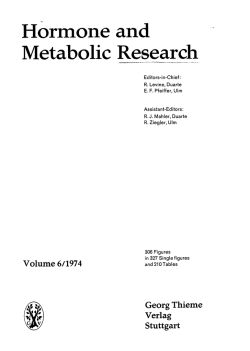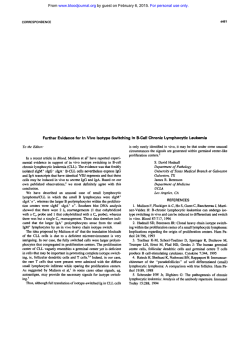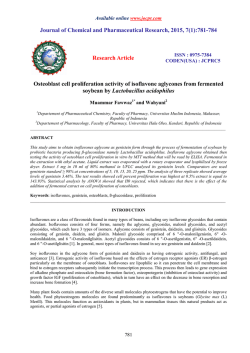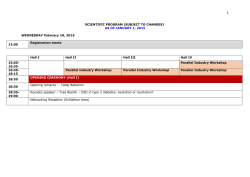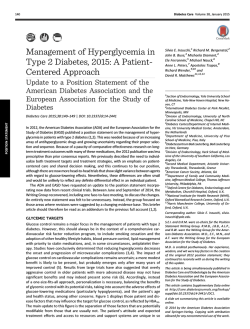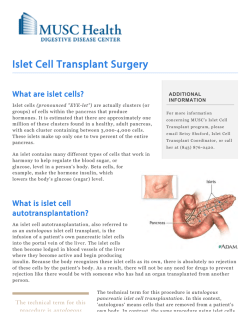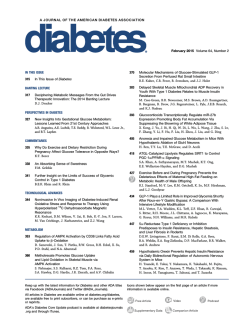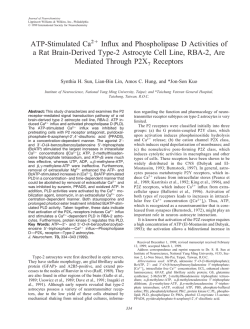
E-cadherin interactions regulate β-cell proliferation in islet
University of Warwick institutional repository: http://go.warwick.ac.uk/wrap This paper is made available online in accordance with publisher policies. Please scroll down to view the document itself. Please refer to the repository record for this item and our policy information available from the repository home page for further information. To see the final version of this paper please visit the publisher’s website. Access to the published version may require a subscription. Author(s): Isidora Kitsou-Mylona, Christopher J. Burns1, Paul E. Squires2, Shanta J. Persaud, Peter M. Jones Article Title: A Role for the Extracellular Calcium-Sensing Receptor in Cell-Cell Communication in Pancreatic Islets of Langerhans Year of publication: 2008 Link to published version: http://dx.doi.org/10.1159/000185540 Publisher statement: None A role for the extracellular calcium-sensing receptor in cell-cell communication in pancreatic islets of Langerhans. I Kitsou-Mylona, CJ Burns1, PE Squires2, SJ Persaud, PM Jones Beta Cell Development and Function Group, School of Biomedical and Health Sciences, King’s College London, Guy’s Campus, London SE1 1UL, UK 1 Endocrinology Section, Biotherapeutics, NIBSC, Potters Bar, Hertfordshire, UK 2 Molecular Physiology, Biomedical Research Institute, Department of Biological Sciences, University of Warwick, UK Short title: Calcium sensing receptor and pancreatic β-cell function Corresponding author: Peter M Jones Beta Cell Development and Function Group Hodgkin Building (HB 2.10N) Guy’s Campus King’s College London London SE1 1UL Tel: +44 (0)207 848 6273 Fax: +44 (0)207 848 6280 e-mail: [email protected] Keywords: islet of Langerhans, pancreatic β-cell, calcium-sensing receptor, insulin secretion, proliferation 1 Abstract Background: The extracellular calcium-sensing receptor (CaR) is expressed in many tissues that are not associated with Ca2+ homeostasis, including the endocrine cells in pancreatic islets of Langerhans. We have demonstrated previously that pharmacological activation of the CaR stimulates insulin secretion from islet -cells and insulin-secreting MIN6 cells. Methods: In the present study we have investigated the effects of CaR activation on MIN6 cell proliferation and have used shRNA-mediated CaR knockdown to determine whether the CaR is involved in the regulation of insulin secretion via cell-cell communication. Results: CaR activation caused the phosphorylation and activation of the p42/44 MAPK signalling cascade, and this activation was prevented by the shRNA-induced downregulation of CaR mRNA expression. CaR activation also resulted in increased proliferation of MIN6 cells, consistent with the known role of the p42/44 MAPK system in the regulation of -cell proliferation. Down-regulation of CaR expression had no detectable effects on glucose-induced insulin secretion from MIN6 cells maintained as monolayers, but blocked the increases in insulin secretion that were observed when the cells were configured as three-dimensional islet-like structures (pseudoislets), consistent with a role for the CaR in cell-cell communication in pseudoislets. Conclusion: It is well established that islet function is dependent on communication between islet cells and the results of this study suggest that the CaR is required for βcell to β-cell interactions within islet-like structures. 2 Introduction Islets of Langerhans form the minority (<5%) part of the mammalian pancreas where they comprise small (100-200 m) clusters of endocrine cells (3000-5000) that are scattered throughout the exocrine pancreas. Insulin-expressing β-cells are the majority islet endocrine cell type (60-70%), but islets also contain glucagon-expressing (10-20%), somatostatin-expressing -cells -cells (~5%), low numbers of ghrelin- and pancreatic polypeptide-expressing cells, and a variety of non-endocrine cell types from the vasculature and immune system. Individual islets are complex functional units which play a crucial role in regulating glucose homeostasis – loss of β-cells or failure of their secretory function results in the pathologies collectively known as diabetes mellitus. The mechanisms through which individual β-cells recognise and respond to extracellular signals are fairly well understood, but it is much less clear how interactions between islet cells regulate the integrated function of the islet as an endocrine unit. Intra-islet interactions are known to be essential for normal function: dispersal of islets into individual cells results in greatly reduced secretory responsiveness [1] which can be restored upon reaggregation of the cells into islet-like structures [1]. There are numerous potential mechanisms of intra-islet communication, including direct cell-cell contact via gap-junctions or cell adhesion molecules, and paracrine interactions via secreted agonists [2]. The heterogenous composition of a primary islet facilitates complex interactions between different cell types [2] but our studies using insulin-expressing MIN6 cells configured as islet-like structures [3, 4] suggest that homotypic interactions between β-cells are very important in the regulation of β-cell function. The current study addresses the possible role of the extracellular Ca2+-sensing receptor (CaR) in regulating islet function by acting as an intra-islet mechanism of homotypic communication between adjacent β–cells. 3 The CaR is a G-protein-coupled, seven transmembrane-spanning domain receptor which enables cells to detect and respond to changes in extracellular Ca2+ and other divalent cations [5]. CaR expression is traditionally associated with cells and tissues that are involved in the regulation of systemic Ca2+ levels, such as the parathyroid gland, kidney and bone, but it is now well established that the CaR is also expressed in cells that are not involved in Ca2+ homeostasis (e.g. oligodendrocytes [6], breast duct cells [7], fibroblasts [8], pancreatic acinar cells [9]), where it is associated with diverse functions including cell proliferation [6-8] and the regulation of secretion [9]. Our previous studies have shown that the CaR is expressed by islet β- and -cells, but not by -cells [10], and that pharmacological activation of the islet CaR using the calcimimetic A568 results in enhanced secretion of insulin and glucagon [11], suggesting an important function for CaR in regulating islet secretory function. More recently, we have shown that CaR expression is regulated by the anatomical configuration of insulin-secreting β-cells, being up-regulated in dispersed cells, and down-regulated in cells configured as islet-like clusters (pseudoislets; [12]). It has long been known that insulin secretory granules contain high concentrations of divalent cations (Ca2+, Mg2+, Zn2+) that are co-released with insulin on exocytosis of the granule contents [13], and these divalent cations may reach sufficient local extracellular concentrations to activate the CaR [14, 10]. The localised presence within islets of high concentrations of extracellular cations and the CaR offers a potential novel mechanism of intra-islet communication. In the present study we have used shRNA-mediated CaR knockdown to investigate the role of the CaR in the regulation of islet function, focusing on β-cell proliferation and insulin secretion. 4 Materials and Methods Insulin-expressing MIN6 cells were obtained from Dr. Y. Oka and J.-I. Miyazaki (Univ. of Tokyo, Tokyo, Japan). DMEM, glutamine, penicillin-streptomycin, gelatin (from bovine skin), PBS, foetal bovine serum and trypsin-EDTA were from Sigma-Aldrich (Poole, Dorset, U.K.). RNeasy Mini RNA extraction kits were obtained from Qiagen (Crawley, West Sussex, U.K.). PCR primers were prepared in-house (Molecular Biology Unit, King’s College London), and real-time quantitative PCR was performed using a LightCycler rapid thermal cycler system from Roche Diagnostics (Burgess Hill, West Sussex, U.K.). The colorimetric cell proliferation ELISA assay (Roche Diagnostics, Burgess Hill, West Sussex, U.K.) was used in this study to quantify cell proliferation. Polyacrylamide gels (10%), molecular mass markers, sample buffer, and PAGE buffers were from Invitrogen (Paisley, U.K.). The enhanced chemiluminescence (ECL) detection system and Hyperfilm were from GE Healthcare(Buckinghamshire, U.K.). The MEK inhibitors PD98059 and UO126 were from Calbiochem (Nottingham, UK). The calcimimetic A568 was from Amgen Inc (Thousand Oaks, CA, USA). Rabbit polyclonal anti-ACTIVE® MAPK antibody was from Promega (Southampton, UK), and mouse monoclonal total p42/44 MAPK antibody was from Transduction Laboratories (BD Biosciences, Oxford, UK). Horseradish peroxidase (HRP)-conjugated goat anti-mouse IgG and goat anti-rabbit IgG were from Pierce Biotechnology (Rockford, IL, USA). The MISSION™ TRC shRNA kit (Sigma-Aldrich, St Louis, MO, USA) was used for the downregulation of CaR using lentiviral vectors. Cell culture and pseudoislet formation. MIN6 cells were maintained at 37oC / 5% CO2 in DMEM supplemented with FBS, penicillin / streptomycin, glutamine and G418, as described [3].. The medium was changed every 3 days and the monolayers were passaged or used for experiments when 70% confluent. MIN6 pseudoislets were 5 generated by culturing MIN6 cells for 7 days on tissue culture flasks that had been precoated with gelatin, as described previously [3]. Quantification of CaR mRNA levels Messenger RNA was isolated from MIN6 cells using the RNeasy Mini Kit according to the manufacturer’s instructions, mRNA was quantified using a Nanodrop spectrometer (NanoDrop, Rockland, ME) and cDNA was synthesised as described [15]. Mouse CaR forward and reverse PCR CACTGCGGCTCATGCTTTCAC-3’, (amplifies a fragment of 414bp). primers were reverse, as follows: forward, 5’- 5’-GCCTGGTGTCTGTTCAAAGTG-3’ Forward and reverse actin PCR primers were as follows: forward: 5’-ACG GCC AAG TCA TCA CTA TTG-3’; reverse: 5’-AGC CAC CGA TCC ACA CAG A-3’, the predicted size of the actin PCR product was 300bp. CaR standards ranging from 10 copies to 109 copies DNA were prepared as described [15]. Real-time PCR amplifications were performed using a LightCycler rapid thermal cycler system in a 10µl volume containing nucleotides, Taq DNA polymerase, and buffer (all included in the LightCycler FastStart Reaction Mix SYBR Green I; Roche Diagnostics, Burgess Hill, West Sussex, U.K ); template cDNA; 5mM MgCl2 and 0.5µM primers. All PCR protocols included an initial 10 min denaturation step and each cycle subsequently included a 95oC denaturation for 0s, annealing for 10s at 58oC (actin) or 61oC (CaR), and a 72oC extension phase for 14s (actin) or 25s (CaR). Fluorescence measurements were taken at 83oC (actin) or 85oC (CaR) for 3s to eliminate fluorescence from primerdimer formation. The amplification products of both primer pairs were subjected to melting point analyses and subsequent gel electrophoresis to ensure specificity of amplification. 6 Down-regulation of CaR expression in MIN6 cells The MISSION™ TRC shRNA kit was used to down-regulate CaR expression in MIN6 cells. The manufacturers supplied five shRNA constructs targeting the mouse CaR mRNA, and appropriate control constructs. The sequences of the shRNA constructs were not supplied. MIN6 cells were seeded onto 96-well plates ata density of 20,000 cell/well and transduced according to the manufacturer’s instructions. Clonal selection of transduced cell was by puromycin (5μg/ml) resistance and expansion over approximately 30 days. In the current study clones were expanded after transduction with two CaR shRNA contructs (CaR2 and CaR4) and control clones were generated using lentiviral particles carrying a shRNA construct that was not directed at the CaR (non-target control), or with lentiviral particles containing an empty construct (non- shRNA control). MAPK expression and activity Suspensions of MIN6 cells (1 x106 cells/500μl) were incubated (37oC, 5 min) in a physiological salt solution in the presence or absence of 1.3mM CaCl2 or A568 or the MEK inhibitors PD98059 and UO126. Cells were pelleted by centrifugation (10000g, 1min), the supernatant was discarded and protein extracts were prepared as described [11,16]. Proteins were separated by polyacrylamide gel electrophoresis, transferred to membranes and immunoprobed for p42/44 MAPK and for phosphorylated (activated) MAPK, as described [11,16]. Cell Proliferation. DNA synthesis as a marker of cell proliferation was assessed by measuring the incorporation of 5-bromo-2’-deoxyuridine (BrdU) using two methods. Measurements of the incorporation of BrdU into cell populations used a commercially available colorimetric 7 assay kit, essentially according to the manufacturer’s instructions. Briefly, MIN6 cells were seeded into 96-well microtitre plates at a density of 3,000 cells/well and were left to adhere overnight in a 37oC/ 5% CO2 incubator, followed by overnight incubation in serum-free culture medium containing 5.5mM glucose. Cells were subsequently incubated for 2.5 hours in serum-free culture medium containing 5.5mM glucose in the presence of 10μM BrdU and various concentrations of test agents. Where the rate of proliferation was compared between monolayer and pseudoislet populations, the method was followed as previously described [17]. Measurements of BrdU incorporation into individual MIN6 cells used a microfluorimetric method to localise BrdU immunoreactivity in MIN6 cell nuclei, essentially as described previously [18]. Briefly, MIN6 cells were seeded onto 3-aminopropyl-triethoxysilane (APES) treated cover glass at a density of 30,000 cells/well and left to adhere overnight under standard tissue culture conditions (95% CO2/5%O2; 37oC) in DMEM supplemented with 15% FCS. Cells were then washed in sterile PBS and serum starved for 2hrs in fresh DMEM containing glucose (5.5mM) and nominal calcium (0.25mM) before a final 3hr incubation in media containing various concentrations of calcium (0, 0.5 and 2.5mM) and BrdU (10 M). Cells were fixed with 4% paraformaldehyde and their DNA denatured using 1M HCl (30min at RT) before incubating in Alexa-594-conjugated anti-BrdU (Molecular Probes, Invitrogen) at 1:200 and storing overnight at 4oC. After repeated washing (PBS /triton (0.01%)) BrdU incorporation was determined using an Axiovert 200 inverted fluorescent microscope (Carl Zeiss, Welwyn Garden City, UK). Six different wells were used for each treatment and the number of BrdU-positive cells counted in each sample exceeded 100cells/well. Insulin secretion Insulin secretion from MIN6 cells and MIN6 pseudoislets was measured using a multichannel perifusion apparatus maintained in a 37oC temperature controlled room, as 8 described previously [19-21]. Perifusate fractions were collected every 2 min and insulin and glucagon content, as appropriate, was determined by radioimmunoassay [22]. Statistical analysis of differences between secretory responses used the total areas under the curves in the perifusion experiments. Results CaR down-regulation and coupling Quantitative RT-PCR analysis of MIN6 cell cDNA demonstrated the expression of CaR mRNA (Figure 1), confirming our previous report [12]. The data in Figure 1 also show that the CaR4 shRNA construct caused a marked down-regulation of CaR mRNA levels in the stably-transfected CaR4 MIN6 cell clone, whereas the CaR2 shRNA construct did not significantly reduce CaR mRNA expression. The shRNA-induced down-regulation in CaR mRNA expression resulted in decreased signalling through the CaR, as shown in Figure 2. In control MIN6 cells the phosphorylation and activation of p42/44 MAPK was induced by extracellular Ca2+ (1.3mM) in the presence or absence of the calcimimetic CaR agonist, A568 (0.1 M; Figure 1 A, B, lanes 3, 4), and this activation was blocked by the presence of pharmacological inhibitors of MAPK kinase (MEK; lanes 5,6, PD98059, UO126). In the CaR4 MIN6 cells the stimulatory effects of Ca2+±A568 were greatly reduced (Fig.1 C, D lanes 3, 4), consistent with a down-regulation in functional CaR in these cells. The effect of CaR-downregulation to reduce p42/44 phosphorylation is also apparent in the immunoblots shown in Figure 1 panels E and F, in which extracts from control and CaR4 MIN6 cells have been loaded on to adjacent lanes to allow direct comparisons. The CaR4 MIN6 cell clone was therefore used for further studies of the effects of CaR down-regulation on MIN6 cell function. CaR and MIN6 cell proliferation 9 The incorporation of BrdU into newly synthesized DNA was used to assess the effects of experimental treatments on MIN6 cell proliferation, using two different methods. Colorimetric measurements of BrdU incorporation into populations of MIN6 cells give quantitative estimates of the total DNA synthesis of the population, but gives no information about the number of cells in the population which are in a proliferative state. In contrast microfluorimetric analysis of BrdU immunostaining does not give quantitative estimates of changes in the rate of DNA synthesis but does give direct information on the number of cells in the population which are actively proliferating. Activation of the CaR by the calcimimetic A568 [23] in the presence of a physiological concentration (1.3mM) of extracellular Ca2+ ([Ca2+]o) stimulated the rate of BrdU incorporation into MIN6 monolayer cells (Fig. 3, upper panel). The effects of A568 on MIN6 cell proliferation were not concentration-dependent, as has also been reported for its effectson insulin secretion from islets and MIN6 cells [11], consistent with A568 acting allosterically to increase the affinity of the CaR for cations rather than acting as a direct agonist at the CaR [23]. The presence of [Ca2+]o alone (0.5 and 2.5mM) also stimulated MIN6 cell proliferation as assessed by microfluorimetric analysis of the percentage of the total cell population that incorporated BrdU (Fig. 3 middle panel), consistent with the [Ca2+]o -dependent activation of MIN6 cell p42/44 MAPK (Fig. 2) via the CaR. In accordance with these observations, the A568- and [Ca2+]o-dependent increases in BrdU incorporation were significantly (P<0.01) reduced by the presence of the p42/44 MAPK inhibitors PD98059 (50µM; 89±2% control, n=8) or U0126 (20µM; 78±3% control, n=8). The shRNA-induced down-regulation of CaR expression had no detectable effect on the basal rate of proliferation of MIN6 cells maintained in monolayer culture. Thus, BrdU incorporation into the CaR4 MIN6 cell clone was not significantly different from that of control cells when grown as adherent monolayers (CaR4 monolayers, 102±4% control, n=3, p>0.2). However, as shown in Figure 3 (lower panel) reduced CaR expression had 10 marked effects on BrdU incorporation when MIN6 cells were configured as pseudoislets, with CaR4 MIN6 cells showing significantly (p<0.01) reduced rates of BrdU incorporation when compared to control MIN6 cells (CaR4 pseudoislets, 49±5% control, n=3, p<0.01), consistent with a localised intra-islet function of the CaR that is not apparent when cells are grown as dispersed monolayers but is revealed when cells are in close apposition in three-dimensional structures. CaR and insulin secretion We have previously demonstrated that pharmacological activation of the CaR stimulated insulin secretion from MIN6 cells and from primary β-cells [11-12]. The measurements of insulin secretion shown in Figure 4 (upper panel) demonstrate that configuring control MIN6 cells as three-dimensional pseudoislets caused enhanced insulin secretory responses to glucose over those of equivalent cells grown as monolayers, confirming our previous observations [1-3]. Thus, the MIN6 cells grown as pseudoislets consistently showed a peak glucose-induced (20mM) insulin secretory response of approximately 300% over basal (2mM), while the maximum response of monolayer cells was an approximately 80% increase. The reduced expression of the CaR in CaR4 MIN6 cells had no significant effect on insulin secretion when the cells were grown as monolayers (CaR4 monolayers, 148±23% control, n=4, p>0.1). However, reduced CaR expression was associated with reduced glucose-induced insulin secretion when the cells were configured as pseudoislets, as shown in Figure 4 (lower panel) which compares the insulin secretory responses of pseudoislets formed from control MIN6 cells with those formed from CaR4 MIN6 cells. The role of the CaR in insulin secretion from pseudoislets was further investigated by exposing glucose-stimulated (20mM) pseudoislets to KCl (20mM) as a directly-depolarising stimulus, in contrast to glucose which is dependent 11 upon glycolytic metabolism. When expressed relative to the maximum glucose-induced (20mM) secretory response there was no significant difference in KCl-induced insulin secretion between pseudoislets formed from control MIN6 cells or those formed from CaR-deficient CaR4 MIN6 cells (control pseudoislets, 165±4% increase; CaR4 pseudoislets 179±8%, n=4, p>0.1). 12 Discussion The CaR is now known to be expressed in cell types which are not involved in systemic Ca2+ homeostasis, suggesting that its prime function in these cells is something other than the detection of circulating Ca2+ [6-8, 24, 25]. One alternative function for the CaR may be to detect and respond to localized rather than systemic changes in [Ca2+]o and the CaR has been implicated in the detection of Ca2+ concentrations in pancreatic juice [9] and the intestinal lumen [26], and as a mechanism through which neuronal cells are influenced by the electrical activity of their near neighbours via local changes in [Ca2+]o [27]. We have reported previously that pancreatic endocrine cells express the CaR [10, 11], and that its pharmacological activation stimulates secretion of insulin and glucagon [11,12]. The aim of the current study was to determine whether the β-cell CaR is involved in intra-islet cell-cell communication by detecting the localized release of divalent cations that are stored in β-cell secretory granules and co-released with insulin [13]. The obvious experimental approach of depleting insulin secretory granules of their cation content was not feasible because this causes a failure of secretory vesicle formation and disrupts the secretory process [28]. The alternative approach of using extracellular chelators to sequester secreted cations was also not feasible because an influx of [Ca2+]o is essential for normal insulin secretion. We therefore adopted the strategy of manipulating β-cell CaR and, in the absence of commercially-available, selective CaR antagonists, we used shRNA-mediated RNA interference to manipulate CaR expression. Primary islets are heterogenous organs [2] and studies of cell-cell interactions are complicated by numerous interactions between the different islet cell types [2]. We have therefore developed methods to generate islet-like structures (pseudoislets) from the MIN6 mouse insulin-secreting cell line [29] as a simple and welldefined model in which to study homotypic β-cell interactions [1-4, 17]. MIN6 cells have the additional advantage over primary β-cells of being amenable to transduction and 13 selection which facilitated the generation of stable CaR under-expressing cell lines, such as the CaR4 MIN6 cells used in the present study. The reduced expression of CaR mRNA in these cells was accompanied by reduced functional activity of the CaR, as assessed by p42/44 MAPK activation, thus validating CaR4 MIN6 cells as a useful model for studying CaR involvement in β-cell function. CaR activation has been associated with increased proliferation in a variety of cell types, including fibroblasts [8], astrocytoma cells [30], and osteoblasts [31], and our results are consistent with a role for the CaR in the regulation of β-cell proliferation. There are technical difficulties associated with measurements of β-cell proliferation in primary islets, largely because of the very low mitotic index of primary β-cells in adult islets, and MIN6 cells have been used as substitutes in several studies of β-cell proliferation [18, 32-34]. Proliferative MIN6 cells constitutively over-express the SV40 large T antigen [29] which de-regulates their cell cycle [29]. However, the results of the current study and previous studies [34, 35] demonstrate that at least part of the MIN6 cell proliferative capacity is regulated by extracellular signals, validating this experimental model. In the present study, pharmacological activation of the CaR stimulated MIN6 cell proliferation and this was due, at least in part, to an increase in the number of cells in the proliferative state. The CaR-induced increase in MIN6 cell proliferation was associated with activation of the p42/44 MAPK pathway which has been implicated in cell-cycle regulation in a wide variety of mammalian tissues [38-40], including MIN6 cells [18]. Our results demonstrated that the presence of [Ca2+]o was alone sufficient to activate p42/44 MAPK and enhance MIN6 cell proliferation, consistent with reports in other cell types that elevated [Ca2+]o can activate p42/44 [36] and increase cell proliferation [37]. The current results also show that further pharmacological activation of CaR using an allosteric activator (A568) enhanced MIN6 cell proliferation at a physiological 14 concentration of [Ca2+]o. The involvement of p42/44 MAPK in transducing signals from the β-cell CaR was confirmed by the inhibitory effects of two pharmacological agents, PD98059 and UO126, both of which inhibit the activity of the mitogen-activated ERKactivating kinase (MEK) which is upstream of the p42/44 MAPKs. These observations are consistent with our previous report that CaR-dependent stimulation of insulin secretion from MIN6 pseudoislets was associated with the activation of p42/44 MAPK and was inhibited by the presence of MEK inhibitors [11], and suggest that transduction through p42/44 MAPK cascade is central to the effects of CaR activation on β-cell function. The reduced levels of CaR expression in CaR4 MIN6 cells did not influence their proliferative capacity when the cells were grown as monolayers, suggesting that the levels of CaR expression per se do not affect the growth rate of MIN6 cells. However, the CaR-depleted cells showed significantly reduced rates of proliferation when configured as pseudoislets, consistent with signalling through the CaR being involved in the regulation of β-cell proliferation in situations where the cells are sufficiently close to communicate by localized release of an endogenous CaR activator (i.e. pseudoislets), but not where the cells are anatomically separate (i.e. monolayers). Thus, the current studies of CaR involvement in β-cell proliferation are consistent with a model in which βcells within islet-like structures influence neighbouring β-cells by releasing an endogenous activator of the CaR (Ca2+, other divalent cations) which increases the proliferative capacity of neighbouring β-cells through CaR activation of the p42/44 MAPK cascade. The physiological significance of this proposed mechanism is uncertain, but the β-cell mass increases at times of increased demand for insulin [41, 42], and CaR activation by divalent cations co-released with insulin offers one mechanism through 15 which β-cells can monitor their own secretory activity (autocrine) and that of neighbouring β-cells (paracrine) and adjust their proliferative potential accordingly. The results of this study also suggest an important role for the β-cell CaR in integrating the secretory responses of β-cells in islet-like structures. Thus, insulin secretion from individual MIN6 cells was not affected by manipulating the levels of CaR expression, suggesting that CaR expression is not an important regulator of signal recognition in βcells. However, previous studies have shown that CaR activation is alone sufficient to trigger insulin secretion [11, 12], and our experiments demonstrated that down- regulation of CaR expression prevented the improvement of insulin secretory responses when MIN6 cells were configured as islet-like structures, consistent with CaR activation being an important means of intra-islet communication. Individual -cells are heterogenous and differ in their sensory [43], biosynthetic [44, 45], intracellular Ca2+ [21] and secretory [46] responses to external stimuli. CaR activation by secreted cations offers one mechanism through which an activated -cell could activate less-sensitive neighbouring cells, and thus enable a heterogenous population of cells to mount an integrated response to external signals [2]. A recruiting role for the CaR in islet-like structures is further supported by our observation that CaR down-regulation had no effect on secretory responses of MIN6 pseudoislets to high extracellular K+, a stimulus that bypasses normal metabolic processes and directly activates all the pseudoislet cells. In conclusion, it is well established that normal islet function is dependent on communication between islet cells [2] and the results of this study suggest that β-cell to β-cell interactions via the CaR are one mechanism of this communication. 16 Acknowledgements This work was supported by grants from Diabetes UK (BDA:RD05/0003080) and the Eli Lilly International Foundation. IKM was supported by a MRC postgraduate studentship. 17 References 1. Luther MJ, Hauge-Evans A, Souza K, Jörns A, Lenzen S, Persaud SJ, Jones PM: MIN6 b-cell-b-cell interactions influence insulin secretory responses to nutrients and non-nutrients. Biochemical and Biophysical Research Communications 2006;343:99104. 2. Carvell MJ, Persaud SJ, Jones PM: An islet is greater than the sum of its parts: the importance of intercellular communication in insulin secretion. Cellscience Reviews 2006;3:100-128. 3. Hauge-Evans AC, Squires PE, Persaud SJ, Jones PM: Pancreatic beta-cell-to-betacell interactions are required for integrated responses to nutrient stimuli: enhanced Ca2+ and insulin secretory responses of MIN6 pseudoislets. Diabetes 1999;48:1402-1408. 4. Brereton HC, Carvell MJ, Asare-Anane H, Roberts G, Christie MR, Persaud SJ, Jones PM: Homotypic cell contact enhances insulin but not glucagon secretion. Biochemical and Biophysical Research Communications 2006;344:995-1000. 5. Brown EM and MacLeod R: Extracellular Calcium Sensing and Extracellular Calcium Signaling. Physiol Rev 2001;81:239-297. 6. Chattopadhyay N, Ye CP, Yamaguchi T, Kifor O, Vassilev PM, Nishimura R, Brown EM: Extracellular calcium-sensing receptor in rat oligodendrocytes: expression and potential role in regulation of cellular proliferation and an outward K+ channel. Glia 1998;24:449-458. 18 7. Cheng I, Klingensmith ME, Chattopadhyay N, Kifor O, Butters RR, Soybel DI, Brown EM: Identification and Localization of the Extracellular Calcium-Sensing Receptor in Human Breast. J Clin Endocrinol Metab 1998;83:703-707. 8. McNeil SE, Hobson SA, Nipper V, Rodland KD: Functional Calcium-sensing Receptors in Rat Fibroblasts Are Required for Activation of SRC Kinase and Mitogenactivated Protein Kinase in Response to Extracellular Calcium. J Biol Chem 1998;273:1114-1120. 9. Bruce JIE, Yang X, Ferguson CJ, Elliott AC, Steward MC, Maynard Case R, Riccardi D: Molecular and functional identification of a Ca2+ (polyvalent cation)-sensing receptor in rat pancreas. J Biol Chem 1999;20561-20568. 10. Squires PE, Harris TE, Persaud SJ, Curtis SB, Buchan AM, Jones P: The extracellular calcium-sensing receptor on human beta-cells negatively modulates insulin secretion. Diabetes 2000;49:409-417. 11. Gray E, Muller D, Squires PE, Asare-Anane H, Huang G, Amiel S, Persaud SJ, Jones PM: Activation of the extracellular calcium-sensing receptor initiates insulin secretion from human islets of Langerhans: involvement of protein kinases. J Endocrinol 2006;190:703-710. 12. Jones PM, Kitsou-Mylona I, Gray E, Squires PE, Persaud SJ: Expression and function of the extracellular calcium-sensing receptor in pancreatic β-cells. Archives Of Physiology And Biochemistry 2007;113:98-103. 13. Hutton J: The insulin secretory granule. Diabetologia 1989;32:271-281. 19 14. Perez-Armendariz E and Atwater I: Glucose-evoked changes in [K+] and [Ca2+] in the intercellular spaces of the mouse islet of Langerhans. Advances in Experimental Medicine and Biology 1986;211:31-51. 15. Persaud SJ, Roderigo-Milne HM, Squires PE, Sugden D, Wheeler-Jones C, Marsh PJ, Belin VD, Luther MJ, Jones PM: A Key Role for {beta}-Cell Cytosolic Phospholipase A2 in the Maintenance of Insulin Stores But Not in the Initiation of Insulin Secretion. Diabetes 2002;51:98-104. 16. Gyles SL, Burns CJ, Whitehouse BJ, Sugden D, Marsh PJ, Persaud SJ, Jones PM: ERKs Regulate Cyclic AMP-induced Steroid Synthesis through Transcription of the Steroidogenic Acute Regulatory (StAR) Gene. J Biol Chem 2001;276:34888-34895. 17. Luther MJ, Davies E, Muller D, Harrison M, Bone AJ, Persaud SJ, Jones PM: Cell-tocell contact influences proliferative marker expression and apoptosis in MIN6 cells grown in islet-like structures. Am J Physiol Endocrinol Metab 2005;288:E502-E509. 18. Burns CJ, Squires PE, Persaud SJ: Signaling through the p38 and p42/44 MitogenActivated Families of Protein Kinases in Pancreatic [beta]-Cell Proliferation. Biochemical and Biophysical Research Communications 2000;268:541-546. 19. Jones PM, Persaud SJ, Howell SL: Time-course of Ca2+-induced insulin secretion from perifused, electrically permeabilised islets of Langerhans: effects of cAMP and a phorbol ester. Biochemical and Biophysical Research Communications 1989;162:9981003. 20. Hauge-Evans A, Squires P, Belin V, Roderigo-Milne H, Ramracheya R, Persaud S, Jones P: Role of adenine nucleotides in insulin secretion from MIN6 pseudoislets. Molecular and Cellular Endocrinology 2002;191:167-176. 20 21. Squires P, Persaud S, Hauge-Evans A, Gray E, Ratcliff H, Jones P: Co-ordinated Ca2+-signalling within pancreatic islets: does [beta]-cell entrainment require a secreted messenger. Cell Calcium 2002;31:209-219. 22. Jones P, Salmon D, Howell S: Protein phosphorylation in electrically permeabilized islets of Langerhans. Effects of Ca2+, cyclic AMP, a phorbol ester and noradrenaline. Biochem J 1988;254:397-403. 23. Nemeth EF, Steffey ME, Hammerland LG, Hung BCP, Van Wagenen BC, DelMar EG, Balandrin MF: Calcimimetics with potent and selective activity on the parathyroid calcium receptor. Proceedings of the National Academy of Sciences of the United States of America 1998;95:4040-4045. 24. Hobson SA, McNeil SE, Lee F, Rodland KD: Signal Transduction Mechanisms Linking Increased Extracellular Calcium to Proliferation in Ovarian Surface Epithelial Cells. Experimental Cell Research 2000;258:1-11. 25. Tu CL, Chang W, Bikle DD: The Extracellular Calcium-sensing Receptor Is Required for Calcium-induced Differentiation in Human Keratinocytes. J Biol Chem 2001;276:41079-41085. 26. Ray JM, Squires PE, Curtis SB, Meloche MR, Buchan AM: Expression of the calcium-sensing receptor on human antral gastrin cells in culture. Journal of Clinical Investigation 1997;99:2328-2333. 27. Hofer AM, Curci S, Doble MA, Brown EM, Soybel DI: Intercellular communication mediated by the extracellular calcium-sensing receptor. Nat Cell Biol 2000;2:392-398. 21 28. Cheng H, Beck A, Launay P, Gross SA, Stokes AJ, Kinet JP, Fleig A, Penner R: TRPM4 controls insulin secretion in pancreatic [beta]-cells. Cell Calcium 2007;41:51-61. 29. Miyazaki J, Araki K, Yamato E, Ikegami H, Asano T, Shibasaki Y, Oka Y, Yamamura K: Establishment of a pancreatic beta cell line that retains glucose- inducible insulin secretion: special reference to expression of glucose transporter isoforms. Endocrinology 1990;127:126-132. 30. Chattopadhyay N, Ye CP, Yamaguchi T, Kerner R, Vassilev PM, Brown EM: Extracellular calcium-sensing receptor induces cellular proliferation and activation of a nonselective cation channel in U373 human astrocytoma cells. Brain Research 1999;851:116-124. 31. Huang Z, Cheng SL, Slatopolsky E: Sustained Activation of the Extracellular Signalregulated Kinase Pathway Is Required for Extracellular Calcium Stimulation of Human Osteoblast Proliferation. J Biol Chem 2001;276:21351-21358. 32. Tanabe K, Okuya S, Tanizawa Y, Matsutani A, Oka Y: Leptin Induces Proliferation of Pancreatic [beta] Cell Line MIN6 through Activation of Mitogen-Activated Protein Kinase. Biochemical and Biophysical Research Communications 1997;241:765-768. 33. Yoshitomi H, Fujii Y, Miyazaki M, Nakajima N, Inagaki N, Seino S: Involvement of MAP kinase and c-fos signaling in the inhibition of cell growth by somatostatin. Am J Physiol Endocrinol Metab 1997;272:E769-E774. 34. Muller D, Jones PM, Persaud SJ: Autocrine anti-apoptotic and proliferative effects of insulin in pancreatic [beta]-cells. FEBS Letters 2006;580:6977-6980. 22 35. Carvell MJ, Marsh PJ, Persaud SJ, Jones PM: E-cadherin interactions regulate β-cell proliferation in islet-like structures. Cellular Physiology and Biochemistry 2008;20:617626. 36. Sakwe AM, Larsson M, Rask L: Involvement of protein kinase C-alpha and -epsilon in extracellular Ca2+ signalling mediated by the calcium sensing receptor. Experimental Cell Research 2004;297:560-573. 37. Liao J, Schneider A, Datta NS, McCauley LK: Extracellular Calcium as a Candidate Mediator of Prostate Cancer Skeletal Metastasis. Cancer Res 2006;66:9065-9073. 38. Ahn NG, Weiel JE, Chan CP, Krebs EG: Identification of multiple epidermal growth factor-stimulated protein serine/threonine kinases from Swiss 3T3 cells. J Biol Chem 1990;265:11487-11494. 39. Pagès G, Lenormand P, L'Allemain G, Chambard JC, Meloche S, Pouysségur J: Mitogen-activated protein kinases p42mapk and p44mapk are required for fibroblast proliferation. Proceedings of the National Academy of Sciences of the United States of America 1993;90:8319-8323. 40. Conejo R and Lorenzo M: Insulin signalling leading to proliferation, survival and membrane ruffling in C2C12 myoblasts. Journal of Cellular Physiology 2008;187:96-108. 41. Parsons JA, Brelje TC, Sorenson RL: Adaptation of islets of Langerhans to pregnancy: increased islet cell proliferation and insulin secretion correlates with the onset of placental lactogen secretion. Endocrinology 1992;130:1459-1466. 23 42. Vinink A, Pittenger G, Rafaeloff R, Rosenberg L, Duguid W: Determinants of pancreatic islet mass: a balance between neogenesis and senescence/apoptosis. Diabetes Rev 1996;4:235-263. 43. Kiekens R, In't Veld P, Mahler T, Schuit F, Van De Winkel M, Pipeleers D: Differences in glucose recognition by individual rat pancreatic B cells are associated with intercellular differences in glucose-induced biosynthetic activity. Journal of Clinical Investigation 1992;89:117-125. 44. Schuit FC, In't Veld PA, Pipeleers DG: Glucose stimulates proinsulin biosynthesis by a dose-dependent recruitment of pancreatic beta cells. Proceedings of the National Academy of Sciences of the United States of America 1988;85:3865-3869. 45. Bosco D and Meda P: Reconstructing islet function in vitro. Advances in Experimental Medicine and Biology 1997;426:285-298. 46. Stefan Y, Meda P, Neufeld M, Orci L: Stimulation of insulin secretion reveals heterogeneity of pancreatic B cells in vivo. Journal of Clinical Investigation 1987;80:175183. 24 Figure Legends Figure 1: Down-regulation of CaR mRNA expression by shRNA. MIN6 cells were stably transduced with lentiviral particles containing shRNA constructs against CaR (CaR 2 and CaR 4) or control constructs (non-shRNA control) and CaR mRNA expression was measured by quantitative PCR. The CaR4 shRNA induced a marked reduction (P<0.01) in CaR mRNA compared to non-transduced MIN6 cells (nontransduced control) or to cells transduced with non-shRNA containing lentivirus (nonshRNA control). In contrast, the CaR2 shRNA construct did not induce a significant reduction in CaR mRNA expression (p>0.2). The results are expressed relative to copy number for actin mRNA in the same extracts. Data are means + SEM, n=3. ***p<0.01 vs both control samples. 25 Figure 2: Decreased signalling through CaR in shRNA CaR4 expressing MIN6 cells. The Figure shows immunoblot analysis of phosphorylated p42/44 MAPK (A,C,E) and total immunoreactive p42/44 MAPK (B,D,F) in control MIN6 cells (A, B,E,F) or in CaR4transduced MIN6 cells (C,D,E,F). [A, B] Incubation of control MIN6 cells in the presence of Ca2+ (1.3mM) in the absence (lane 3) or presence of 0.1 µM A568 (lane 4) induced a rapid increase in the phosphorylation of p42/44 MAPK (panel A), that was inhibited by the presence of the MEK inhibitors PD98059 (50 M) or UO126 (20 M), consistent with a CaR-dependent activation of p42/44 MAPK. The membrane was stripped and re-probed with an antibody against total p42/44 MAPK immunoreactivity (panel B). [C, D] In CaR4 shRNA transduced cells the effects of Ca2+ in the absence (lane 3) or presence of 0.1 µM A568 (lane 4) on p42/44 MAPK phosphorylation were much reduced, consistent with the down-regulation of functional CaR expression in this MIN6 cell clone. Panel D shows total p42/44 MAPK immunoreactivity in the samples from panel C. Results show one experiment typical of three. [E,F] These blots show phosphorylated p42/44 MAPK (E) or total p42/44 (F) in extracts from control MIN6 cells (lanes 1,3,5) or CaR4 MIN6 cells (lanes 2,4,6) to allow direct comparisons between control and CaR-depleted cells. The presence of Ca2+ (1.3mM) in the absence (lanes 3,4) or presence of 0.1 µM A568 (lanes 5,6) induced a rapid increase in the phosphorylation of p42/44 MAPK in control MIN6 cells (lanes 3,5), but this was much reduced in CaR4 shRNA transduced cells (lanes 4,6). 26 Figure 3: CaR activation and MIN6 cell proliferation MIN6 cell proliferation was assessed by measuring the incorporation of BrdU into newlysynthesized DNA using an anti-BrdU antibody. Upper panel: BrdU incorporation into MIN6 populations. MIN6 cells grown as monolayers in 96 well tissue culture plates were incubated for 2.5 hours in serum-free culture medium containing 5.5mM glucose in the presence of 10μM BrdU and different concentrations of the calcimimetic A568, as shown. BrdU incorporation was assessed by colorimetric assay using an HRP-linked anti-BrdU antibody. Data are expressed as percentage of the basal BrdU incorporation into cells incubated in serum-free/5.5mM glucose culture medium, in the absence of A568. Bars show means+SEM, n=8. *** P<0.01 versus basal proliferation. The Figure shows one experiment typical of three separate experiments. Middle panel: BrdU incorporation into individual MIN6 cells. MIN6 cells grown as monolayers on glass coverslips were incubated for three hours in medium containing various concentrations of Ca2+, as shown, with BrdU (10μM) being present for the final two hours of the incubation. Fluorescence microscopy was used to detect BrdU incorporation into MIN6 cell DNA using an Alexa 594-conjugated conjugated anti-BrdU antibody. A minimum of 100 cells were counted on each coverslip and results are expressed as the percentage of the total number of cells which showed positive nuclear immunofluorescence for BrdU. Bars show mean+SEM for 6 different coverslips. ** P<0.05, *** P<0.01 versus absence of Ca2+. Lower panel: CaR downregulation reduced proliferation in MIN6 pseudoislets CaR4-transduced MIN6 cells showed no changes in BrdU incorporation compared to control MIN6 cells when grown as monolayers (p>0.2). However, configuring the CaR4 MIN6 cells as pseudoislets caused a significant reduction in BrdU incorporation when 27 compared to control MIN6 cells configured as pseudoislets. Bars show means+SEM, n=3, ***p<0.01. 28 Figure 4: Effects of CaR down-regulation on insulin secretion Upper panel: Effect of cell configuration on insulin secretion Control (non-shRNA vector transduced) MIN6 cells configured as monolayers (○) or as pseudoislets (●) were perifused with buffer containing 2mM glucose for 10 minutes (0-10 min) to achieve a basal rate of secretion, after which they were exposed to a buffer containing 20mM glucose. Cells configured as pseudoislets showed significantly (p<0.001) enhanced secretory responses when compared to equivalent cells maintained as monolayers. Secretion is expressed as a percentage of basal (2mM glucose) secretion. Points show means ± SEM, n=4, and statistical analysis compares areas under the curves between groups. Lower panel: Effects of CaR down-regulation on insulin secretion from pseudoislets. Pseudoislets formed from control (●) or CaR-depleted (○) CaR4 MIN6 cells were perifused with buffer containing 2mM glucose for 10 minutes (0-10 min), after which they were exposed to a buffer containing 20mM glucose. Insulin secretion from the CaR4 pseudoislets was significantly less (p<0.001) than from control pseudoislets, Secretion is expressed as a percentage of basal (2mM glucose) secretion. Points show means ± SEM, n=4. 29
© Copyright 2024
